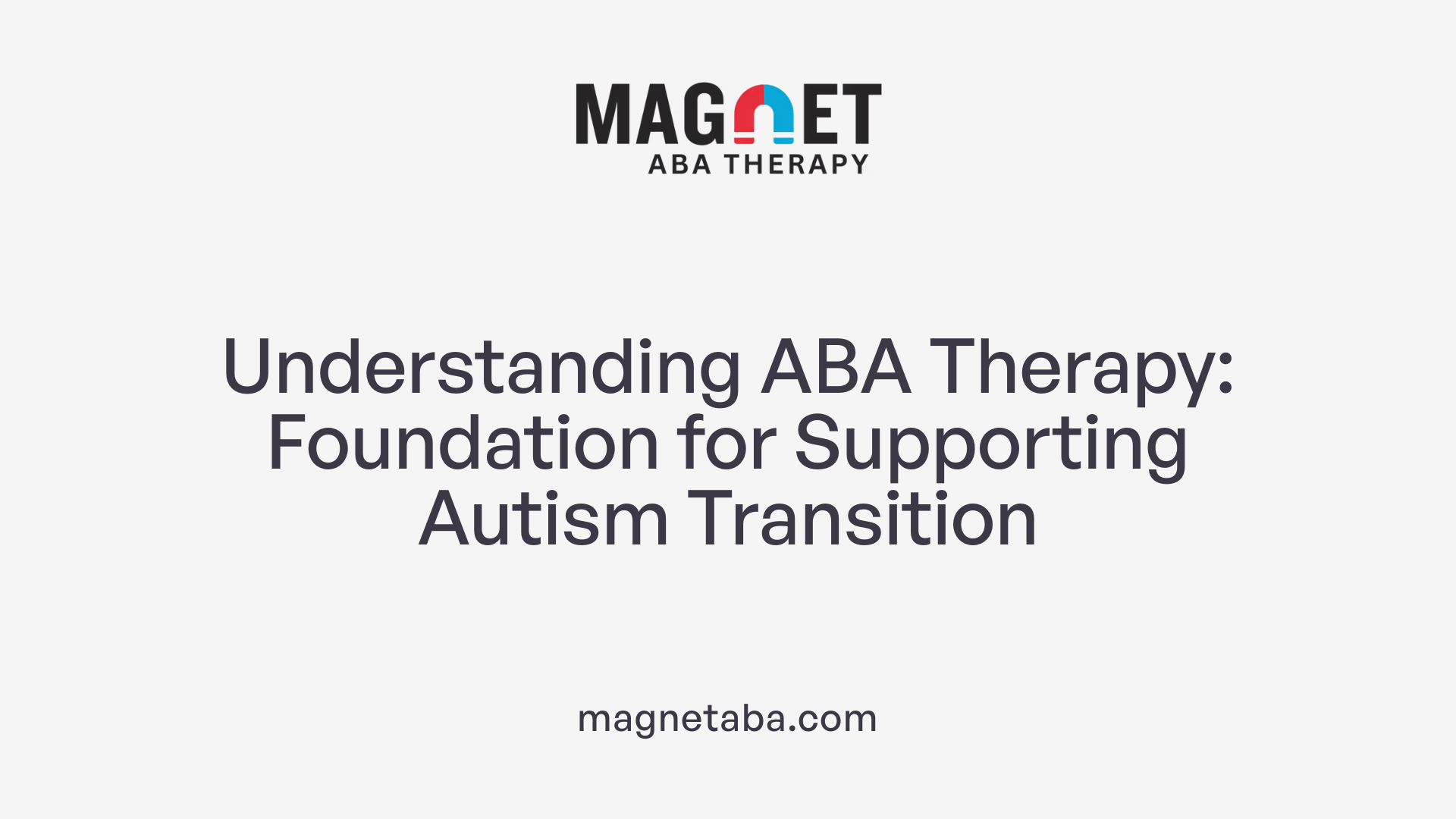Understanding the Role of ABA Therapy in Transition Support
Applied Behavior Analysis (ABA) therapy is a foundational approach in helping children with autism successfully navigate transitions, particularly from therapeutic settings to the school environment. This article explores how ABA supports these transitions through targeted strategies that promote independence, reduce anxiety, and foster essential skills for school readiness.
What is Applied Behavior Analysis Therapy and Its Role in Autism Transition Support?

What is Applied Behavior Analysis (ABA) Therapy?
Applied Behavior Analysis (ABA) therapy is a science-driven approach aimed at enhancing social, communication, and learning skills for individuals with autism. It works by applying behavioral principles to increase beneficial behaviors and reduce challenges through methods such as positive reinforcement and prompting.
Benefits of ABA Therapy for Children with Autism
ABA therapy helps children develop essential skills to navigate daily life more independently. It targets communication abilities, social interaction, and everyday living skills, allowing children to express needs, follow instructions, engage positively with peers, and manage routines effectively.
How ABA Addresses Communication, Social, and Daily Living Skills
ABA programs focus on teaching children to communicate their needs clearly, take turns, share, and participate in groups. They also build self-regulation and coping strategies that prove vital in managing transitions and daily activities, particularly in school settings.
Tailoring ABA Programs to Individual Needs
Each ABA therapy program is custom-designed to meet the unique requirements of the child. Board Certified Behavior Analysts (BCBAs) assess the child’s behavior and skills, then set personalized goals and use ongoing data collection to adjust interventions for maximum effectiveness.
Professionals Delivering ABA Therapy
Trained professionals, including BCBAs and registered behavior technicians, implement ABA therapy in various settings—clinics, homes, and schools. Collaboration among therapists, families, and educators ensures consistent support and helps children apply skills across environments, boosting their success in transitions and daily routines.
Core Principles Guiding ABA Therapy in Supporting Transitions

Positive reinforcement and its application
Positive reinforcement is central to ABA therapy, used to encourage behaviors that support smooth transitions. When a child successfully moves from one activity to another, praise, stickers, or access to a favorite item can strengthen their cooperation and independence. This approach creates positive associations with change, reducing anxiety and resistance.
Behavior observation and data collection
Continuous observation and accurate data collection form the backbone of effective ABA intervention. Therapists carefully monitor how a child responds to transitions, noting which methods improve outcomes and which do not. This systematic tracking allows for adjustments that better suit the individual child's needs.
Analyzing antecedents, behaviors, and consequences (A-B-Cs)
ABA therapy thoroughly examines what happens before a behavior (antecedents), the behavior itself, and the outcomes that follow (consequences). This analysis helps identify triggers that cause transition difficulties and the results that reinforce or discourage specific behaviors. Understanding these links enables targeted intervention planning.
Tailored interventions based on continuous assessment
Interventions in ABA are highly individualized. Based on ongoing data and A-B-C analysis, therapists create customized strategies to support each child’s unique challenges related to transitions. This may include using visual schedules, timers, or transition objects, applied thoughtfully according to the child's progress.
Evidence-based approach underpinning ABA treatment
ABA therapy relies on robust scientific research supporting its techniques and outcomes. Its focus on measurable progress, ongoing assessment, and data-driven decision-making ensures that the treatment remains effective and adaptable. This evidence-based foundation underlines ABA's reputation as a trusted method for assisting children with autism through behavioral challenges, including transitions.
Techniques to Support Transitions from Therapy to School

Utilization of Visual Schedules to Reinforce Routine
Visual schedules are essential tools in Applied Behavioral Analysis (ABA) therapy designed to help children with autism understand daily routines. By presenting a clear sequence of activities, these schedules reduce anxiety by increasing predictability. For example, a visual chart illustrating steps from therapy to school helps children anticipate what comes next, easing their transition.
Timers and Countdown Warnings to Prepare Children for Changes
Timers and countdown warnings serve as advance notices that prepare children mentally for upcoming transitions. By signaling how much time remains before an activity change, these tools build trust and aid in smoother shifts from therapy sessions to school routines. This approach reduces confusion and resistance.
Positive Reinforcement to Encourage Cooperation and Independence
ABA therapy emphasizes the use of positive reinforcement—such as praise, stickers, or access to preferred items—to encourage cooperation during transitions. Reinforcing desired behaviors helps children develop independence and creates positive associations with moving between therapy and school environments.
Use of Transition Objects for Emotional Security
Transition objects like favorite toys or pictures provide emotional comfort during changes. These items act as tangible sources of security, helping children manage the stress of moving from one activity or environment to another.
Gradual Practice and Breaking Transitions into Manageable Steps
Practicing transitions in a structured way—starting with simple steps and progressively increasing complexity—enhances children's flexibility and confidence. Breaking transitions into smaller, manageable parts allows for better adjustment and reduces resistance when shifting from therapy to school activities.
Incorporation of Social Stories and Verbal Cues
ABA therapy also uses social stories and verbal cues to help children mentally prepare for upcoming transitions. These methods provide clear explanations and guidance, reinforcing expectations and boosting understanding of the changes ahead.
ABA techniques combine these strategies to create a supportive framework that eases children’s movement from therapy settings to school, promoting smoother adjustments and positive developmental outcomes.
Promoting Independence and Social Skills for School Success

Teaching communication and functional skills
ABA therapy targets communication skills by helping children express their needs, follow instructions, and engage in appropriate interactions. These abilities are foundational for thriving within a school environment.
Enhancing self-regulation and coping mechanisms
Through tailored behavioral strategies, ABA develops children's capacity for self-regulation and coping. This support enables them to manage daily transitions and routines more effectively, reducing stress and promoting adaptability.
Developing social interaction abilities like sharing and turn-taking
Social skills such as sharing, taking turns, and participating in group activities are strengthened using ABA techniques. These skills foster positive peer relations and ease social integration.
Breaking down pre-academic tasks into manageable components
ABA interventions simplify pre-academic skills by decomposing tasks like following directions, sitting attentively, and completing assignments into achievable steps. Positive reinforcement encourages progress and builds confidence.
Helping children understand and follow classroom rules
Independence is encouraged by teaching children to organize personal belongings, transition smoothly between activities, and comprehend the expectations set by classroom rules. ABA fosters these essential routines.
Collaborative approaches involving therapists, families, and educators
Consistent support is reinforced through teamwork among ABA therapists, families, and educators. This collaboration ensures that skills are effectively generalized and maintained across home and school settings, improving overall outcomes for the child.
Choosing the Right Provider and Collaborative Support Systems

Who typically provides behavioral analysis therapy for autism?
Behavioral analysis therapy for autism is delivered by trained professionals such as Board Certified Behavior Analysts (BCBAs) and licensed therapists. These providers often work within specialized organizations dedicated to autism treatment and may hold accreditations that signify adherence to quality standards.
Delivery models including in-home, clinic, and school-based settings
ABA therapy can be provided through multiple delivery models tailored to the child's needs. Common settings include in-home environments, clinic-based programs, and school-based services. This flexibility allows the therapy to integrate smoothly into a child's daily life, promoting consistent learning and skill generalization.
Importance of family involvement and coaching
Families play an essential role in ABA therapy by receiving coaching from therapists. This involvement ensures parents understand strategies used, can reinforce skills at home, and provide valuable feedback. Engaged families contribute to better outcomes and stronger support networks for their children.
How collaboration ensures consistency and generalization of skills
Effective collaboration between ABA providers, families, and educators is critical. Working together allows for integrating therapeutic goals across settings, maintaining consistency, and helping children generalize learned skills to new environments like school or social settings.
Local resource considerations for accessible supports
For families in Atlanta, GA, local ABA providers offer tailored, accessible programs in homes and clinics. Choosing local resources can ease scheduling, allow face-to-face collaboration, and ensure support that fits individual family needs, supporting children's success in school readiness and daily functioning.
Ensuring Smooth and Successful Transitions
Supporting children with autism in transitioning independently from therapy to school requires careful application of ABA strategies tailored to each child's needs. By emphasizing predictability with visual schedules and timers, encouraging positive behaviors through reinforcement, and fostering independence and social skills, ABA therapy lays the foundation for confidence and success in new environments. Collaboration among therapists, families, and educators ensures these skills generalize effectively, helping children thrive both academically and socially. With qualified providers and individualized support, these transitions can become opportunities for growth and empowerment rather than challenges.
References
- Making Transitions Easier: ABA Tools for Everyday Routines
- How ABA Therapy Supports School Readiness for Child ...
- How ABA Therapy Prepares Children for Change
- Applied Behavior Analysis (ABA)
- The Top 10 Reasons Children With Autism Deserve ABA
- Applied Behavior Analysis (ABA)
- 6 Benefits of ABA Therapy for Children with Autism
- ABA Therapy Providers Directory
- Best ABA Therapy in the Bay Area











